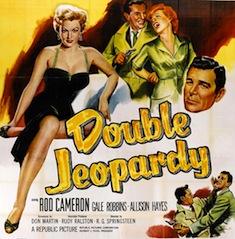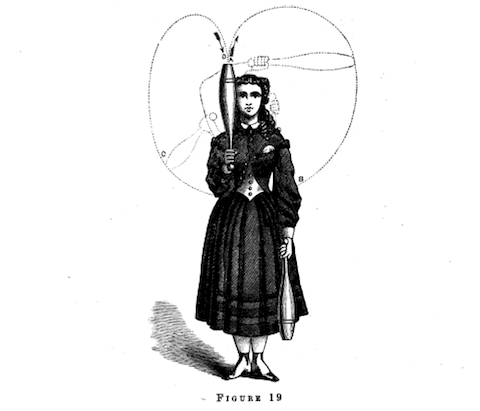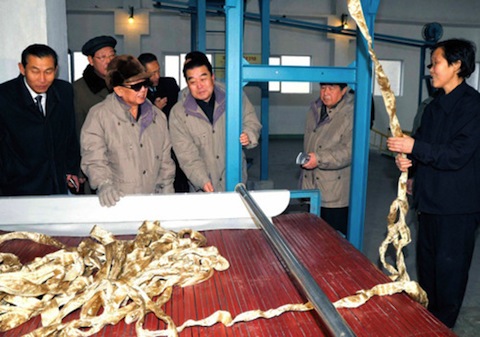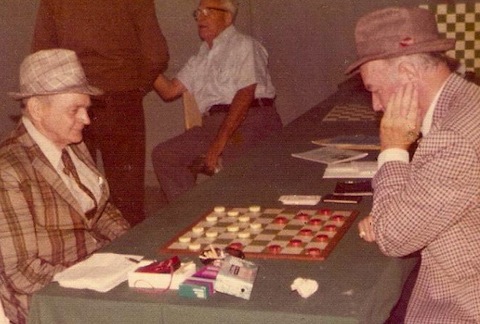June 29th, 2011

So far this year, Microkhan’s coverage of sorcery-related violence has focused primarily on Papua New Guinea, where efforts at legal reform have done little to reduce the bloodshed. Now comes word that my beloved Assam, one of the primary settings for my first book, is dealing with a similarly tragic wave of killings. The latest incident on one of the Indian state’s tea plantations pushed this year’s death toll to at least 18, with several of the victims under the age of 12. Perhaps even more so than their compatriots in Papua New Guinea, Assamese authorities are struggling to devise a way to cope with the epidemic:
Many police officers feel that the State should have a special legislation to deal with the menace of witch hunting. Police sources pointed out that at present, the witch hunting cases are registered as normal murder cases and it is difficult to go for proper documentation of such cases. Moreover, when a whole village is involved in a case, it is difficult to pinpoint the main culprit and it is almost impossible to collect evidence as no one comes forward to testify against anyone. Several other States including Bihar and Jharkhand have already enacted special legislation to deal with witch hunting and it is high time Assam also makes such legislation in the face of spurt in such cases.
The bolded point is key, as most of these attacks do seem to be cases of collective violence. As pointed out here, the slayings are often sparked not by genuine concern over sorcery, but by disputes over property or romantic jealousy. If one of the parties in such a dispute is cynical enough, he can settle the matter by accusing his adversary of black magic, thereby getting his superstitious fellow villagers to take his side and settle the matter through violence. No one tattles because to do so would be to destroy the entire village, since everyone is partially culpable in the killings.
The Assam Police are doing their best by reviving a targeted education campaign called Project Parhari, which aims to disabuse villagers of the notion that malicious sorcery is real. But government representatives can only spend so much time in each settlement, spreading their message of reason. Perhaps the better long-term solution is to provide villagers with better means of dispute resolution—and to ensure that justice is swift and certain when killings do occur, even if it means carting off every single participant.
(Image via TwoCircles.net)
Tags:Assam·crime·India·law·North-East India·witchcraft
June 28th, 2011
 Though my ability to feed my family depends entirely on humankind’s affinity for written communication, I’m often surprised by the power of words. Case in point: the developing brouhaha between Hungary and Romania over a plaque tacked onto a statue of King Matthias (right). The monument is located in the Romanian town of Cluj, where the 15th-century Hungarian monarchy was born. When the local council recently restored the statue, it tacked on a descriptive sign that, due to a single sentence fragment, threatens to poison relations between neighboring NATO members. The plaque’s sin? It quotes from a Romanian historian who seems to believe that King Matthias wasn’t really Hungarian at all:
Though my ability to feed my family depends entirely on humankind’s affinity for written communication, I’m often surprised by the power of words. Case in point: the developing brouhaha between Hungary and Romania over a plaque tacked onto a statue of King Matthias (right). The monument is located in the Romanian town of Cluj, where the 15th-century Hungarian monarchy was born. When the local council recently restored the statue, it tacked on a descriptive sign that, due to a single sentence fragment, threatens to poison relations between neighboring NATO members. The plaque’s sin? It quotes from a Romanian historian who seems to believe that King Matthias wasn’t really Hungarian at all:
In May Hungarian ambassador Oszkár Füzes was stopped by police from placing flowers on a controversial plaque put in front of a statue of medieval Hungarian King Mátyás (Matthias) in the ethnic Hungarian town of Cluj. The plaque, noting a rare battlefield loss by Mátyás to Moldavian forces in 1467, read “he suffered defeat at the hands of his own nation.”
The Romanian Culture Ministry said the inscription had not been approved by the state historical commission and is therefore illegal. However, Cluj town hall claims it proceeded within the law.
More on the ensuing controversy here. As you might imagine, hardcore nationalists on both sides of the Romanian-Hungarian divide have been using the plaque to make political hay. It all seems nonsensical to my thoroughly American brain, especially given the fictional nature of “pure” ethnicity. Wouldn’t an intermingling of genes (and thus heritages) be the norm in an interzone like Cluj?
But some people thrive on a sense of grievance, and thus look for every opportunity to feel as if their identities are being threatened by exceedingly minor slights. Unfortunately, these insecure actors tend to have a disproportionate voice in politics, to the detriment of rational discourse. And so a few words on an obscure plaque end up having serious implications for people who otherwise couldn’t tell King Matthias from King Tubby.
Tags:diplomacy·Hungary·King Matthias·Medieval history·politics·Romania
June 24th, 2011
All the time I spent delving into the Soviet sports machine for my hammer-throw saga got me thinking a lot more about the “Evil Empire” my youth. One of the first truly adult books I read was Hedrick Smith’s The Russians, because I as so curious about what daily life was like in the nation that (according to the politicians and entertainment moguls of the day) desired nothing more than to turn us into slaves. The book was way, way over my grade-school head, but there are certain details I still recall—like this one part about how young Soviets had to hide their affection for The 5th Dimension, since all Western music was considered decadent.
Another facet to my early fascination with the Soviet perspective was how their propaganda differed so markedly from our own—to the point that it seems nothing short of laughable, no matter how beautifully presented. The prime example here is Vladimir Tarasov‘s Shooting Range (above), a truly gorgeous animated short with a message that is basically the the polar opposite of the one conveyed by the Wendy’s Soviet fashion show. A fan of Tarasov’s artistry explains here:
No two ways about it, Shooting Range is pure unadulterated propaganda. Its story is also simple; a young man wanders the bustling metropolis desperately looking for a job, a mere innocent peasant in the hands of corporate evil and greed. So naturally, our hero eventually finds a job from a lasciviously kind tycoon, as a human target in a shooting range. Live in a capitalist world, and you are setting yourself up as a walking bullseye. It’s essentially The Most Dangerous Game for the set who found that film to be a bit too subtle. But once again, the animation is stunning to behold, a sense of movement that really does convey a level of panic in the viewer. That, and it’s hilarious. Intended effect be damned, it’s hilarious.
There’s a question here of how much a laughable message compromises our ability to appreciate the art. Everything about this film is so expertly done—as some YouTube commenters have noted, it almost makes you wish that the Russian style of animation had triumphed over Japanese anime as the go-to obsession for geeks. But as is so famously the case with Triumph of the Will, the political dimension of the film vastly complicates our ability to appreciate it.
I’d love to dig up an interview with Tarasov to see how he came to create such head-thunkingly obvious propaganda, and whether he has any regrets about taking his career in that direction. The anti-Americanism in the film seems to virulent to have simply been put there due to government marching orders; Tarasov’s heart was in this project, for better and for worse.
Tags:animation·propaganda·Soviet Union·Vladimir Tarasov
June 23rd, 2011
 Inspired by The New York Times‘ successful effort to crowdsource a solution to a Nazi mystery, I’ve decided to try something similar in these slightly less august digital pages. Instead of identifying a photographer who documented the brutality of war, my goal is to find out whatever became of Rick Rojatt, a Canadian stuntman who performed daredevil feats under the moniker The Human Fly.
Inspired by The New York Times‘ successful effort to crowdsource a solution to a Nazi mystery, I’ve decided to try something similar in these slightly less august digital pages. Instead of identifying a photographer who documented the brutality of war, my goal is to find out whatever became of Rick Rojatt, a Canadian stuntman who performed daredevil feats under the moniker The Human Fly.
Perhaps you’re familiar with Rojatt’s alter ego, as it was the basis for a short-lived Marvel Comics series in the late 1970s. While the comics made the rounds, Rojatt cashed in by traveling around North America, walking on airplanes and piloting jet-powered motorcycles. He also created for himself quite a mythical backstory, as related in this 1976 People profile:
Rojatt, a Canadian, says he once was a Hollywood stunt man—although the California union has no record of him. He also says he was in an auto accident in North Carolina six years ago which killed his wife and 4-year-old daughter and badly injured him. He had 38 operations in four years, he says, which allowed him to walk again but left him with a body that is “60 percent steel parts.” He says he conditions himself by rising at 3 a.m., running six miles and then plunging into a bathtub full of ice cubes.
But at the very height of his fame, Rojatt suddenly disappeared. The fact that he never appeared without his trusty mask made his incredibly difficult to track—he kept his face concealed even when collected his appearance fees from event promoters. Rojatt’s fate has been the subject of much speculation, the best of which is compiled here. I’m rather fond of the theory that he swapped daredevilry for folk rock, but I fear that the true explanation isn’t quite so pleasant.
I thus appeal to Microkhan readers who may have deep contacts in Canadian stuntman circles. Any idea of what Rojatt did after he ditched the mask for good?
Tags:comics·daredevils·Rick Rojatt·The Human Fly·The New York Times
June 22nd, 2011
 There are few more hallowed legal principles than the protection against double jeopardy, which is enshrined in various constitutions and codes throughout the world. But as allegedly unimpeachable DNA evidence has become more common in courtrooms, a backlash has developed against the centuries-old prohibition against trying a person again after they’ve been acquitted. In Scotland, for example, a new bill has allowed for the retrial of certain suspects if very strong evidence comes to light after an acquittal. And now there’s a serious reform movement afoot Down Under, too:
There are few more hallowed legal principles than the protection against double jeopardy, which is enshrined in various constitutions and codes throughout the world. But as allegedly unimpeachable DNA evidence has become more common in courtrooms, a backlash has developed against the centuries-old prohibition against trying a person again after they’ve been acquitted. In Scotland, for example, a new bill has allowed for the retrial of certain suspects if very strong evidence comes to light after an acquittal. And now there’s a serious reform movement afoot Down Under, too:
The father of one of the victims of the Walsh Street police killings has backed the Victorian government changing the state’s double jeopardy laws.
Frank Eyre, the father of Damian Eyre who was gunned down in 1988 along with colleague Steven Tynan, said he supported changing double jeopardy rules, which prevent acquitted suspects from being retried for the same crime.
According to reports one of the four people acquitted of the Walsh Street killings, Peter John McEvoy, allegedly told police in NSW that the sweetest thing he ever heard was the dying words of one of the young constables…
The coalition government pledged during the November election campaign to shake up double jeopardy rules, with legislation expected to be introduced to parliament before the end of this year.
The legislation will open the way for retrials when there is new and compelling evidence that a person acquitted of a serious crime was in fact guilty.
Attorney-General Robert Clark has said the Walsh Street killings could be one of the cases where a retrial is possible.
I understand the urge to chip away at the double-jeopardy ban, but it makes me pretty uneasy. True, the Founding Fathers and other long-ago lawgivers couldn’t have foreseen how DNA would alter the criminal-justice process. It must be horrific for the families of murder victims to learn years later that some scrap of skin or hair finally nails an acquitted suspect.
But if the ban is scrapped in part, how do we ensure that governments play fair? Double jeopardy was initially done away with because the people didn’t trust their rulers to pursue each case honestly—there was always the fear that on the second attempt, a prosecutor might magically discover some piece of evidence that had previously escaped his attention. Are we at the point where we no longer think that such misconduct is possible?
And perhaps more important, is our faith in scientific evidence a bit too total? My longform take on that issue can be read here. Suffice to say, I think any technology operated by humans is subject to error—and that’s doubly the case when the analysis comes from only one source (that is, from the prosecution). Such evidence needs to be given the most serious consideration at trial, of course, but is it such a gamechanger that it justifies the upending of roughly 900 years of legal tradition? Legislators must ponder that question very carefully.
Tags:Australia·crime·double jeopard·forensic science·law·Scotland·technology
June 21st, 2011
For those loyal Microkhan readers who’ve been wondering why I’ve been posting so much about the hammer throw, consider the mystery solved: my long-gestating ESPN the Magazine piece about Yuriy Sedykh’s 1986 world record is finally out. I’m particularly excited about the story because it grew out of a Microkhan post—back in this ongoing project’s earliest days, I expressed my admiration for Sedykh’s achievement, along with my puzzlement over why it hasn’t been bested in well over two decades. So glad I got the chance to delve deep into the brawny Ukrainian’s backstory, as well as the science of elite athletic achievement. A snippet to whet you appetite:
At 6’1″ and a fleshy 240 pounds, Sedykh was neither the biggest nor the strongest thrower in the Soviet system. But he possessed an attribute that is far more critical to hammer success than mere muscle. “I understand my body,” he says. “I give orders to my body and make everything coordinate.” That skill was key because the hammer throw heavily penalizes the most microscopic of errors. When the ball and wire are whipping around at maximum velocity, every tic is amplified until it threatens to become ruinous. The difference between a gold medal and 28th place is often a matter of a foot pulled a few degrees off-center, or a shoulder dipped an inch too low. Bondarchuk had Sedykh practice with 10- and 12-pound hammers until he understood every nuance of “the dance.”
As he struggled to develop the most seamless throwing motion possible, Sedykh came to view the hammer as having more in common with ballet than the discus. “When you see a ballerina jump, she’s like a bird, how she flies so easy,” he says. “People are always excited when they see this. They cannot imagine how hard it is to come to this easy, the hundreds of hours of practice, practice, practice. This is also true for hammer.”
With so many thousands of throws required to hone technique, the sport’s best competitors are typically in their early 30s. But at 21, Sedykh won gold at the 1976 Olympics in Montreal with a throw of 77.52 meters. Four years later, in the Black Sea resort town of Leselidze, he broke the world record twice at a single meet, raising the top mark to 80.64 meters.
His first reign as world-record holder lasted a mere eight days. On May 24, 1980, a 22-year-old Soviet thrower named Sergey Litvinov stunned the track-and-field world by besting Sedykh’s mark by more than one meter.
The nemesis had arrived.
At some point, I should probably post video of my own attempt to throw the hammer. As I note in the story, it was a pretty disastrous affair, which makes it an awful lot of fun to watch. I just consider myself lucky that I didn’t pull an arm free from a socket.
Tags:ESPN the Magazine·hammer throw·Soviet Union·sports·Yuriy Sedykh
June 20th, 2011

Banging out these words from the new global headquarters in Sunnyside, having left Harlem in the dust after seven wondrous years. As Microkhan Jr. and I headed for the 125th Street subway stop for the very last time, we passed one of the neighborhood oddities I’ll truly miss: the ATLAH World Missionary Church, infamous for its virulent anti-Obama stance. (Straight from the source here.) Standing outside was a girl of about eight, who handed the boy and I the flyer above. Yes, these folks have a day camp, and our progeny could take part for the low, low price of $50 per week (minus unspecified expenses).
As fate would have it, we are looking for some way to occupy Microkhan Jr.’s time now that his preschool has called it a year. But as much fun as that clip art makes the ATLAH camp appear, a few things on this flyer give me pause. For starters, the bold claim at the top regarding the church’s schools being among America’s best. Then there is the completely unexplained reference to “King Totally Good Joseph Day,” which compelled me to look up the holiday’s origins in James David Manning‘s delightfully zany The Oblation Hour, which is subtitled “This is a time-proven method to receive tailor-made, real-time, and fail-proof information on a daily basis to guide your life.” (Points for correct use of serial comma, penalty for repetition of the word “time.”–copy editor).
To briefly summarize: King Totally Good Joseph is a chess-playing angel who Manning met in Prospect Park about 25 years ago. This angel instructed Manning to use only “good words” from that point forward, a commandment that the pastor has evidently violated in his political discourse. KTGJ also displayed a penchant for combat boots and long overcoats—a slightly more badass look that we normally expect from heavenly visitors.
I’m crazy curious about how KTGJ’s holiday is celebrated. But that alone is not reason enough to send Microkhan Jr. to ATLAH’s summer camp. If any readers have the inside scoop on the day’s festivities, please advise.
Tags:Atlah·James David Manning·politics·religion
June 15th, 2011
Little time for Microkhan-ing between now and the weekend, as the Golden Horde is in the midst of packing up its yurts for points not-too-far-afield. After seven years in the blessed Paradise known as Atlah, we’re moving across the East River to a land with a slightly Brave New World-ish name. Always bittersweet to move, but looking forward to at least one fantastic perk: Henceforth, I will be writing in my own private throne room, rather than on the floor of Microkhan Jr.’s chamber.
Hope to get back at y’all sooner rather than later. For now, though, watch the above to learn a bit more about how the Soviet Union managed to so thoroughly dominate the sport of hammer throwing for the better part of the Cold War. As far as I can tell, it was all about balletic footwork, practiced by men just a shade smaller than grizzlies.
Tags:hammer throw·New York City·Queens·Soviet Union·sports
June 14th, 2011

There is great wisdom to be gleaned from studying anomalies, which is why the El Paso Police Department’s homicide unit deserves our attention. It is the rare squad that appears to be solving an ever-greater percentage of its cases, thereby defying the nationwide trend illustrated in the graph above:
Since 2004, unit detectives have investigated 106 slayings and solved all but four of them. Two homicides this year have yet to result in an arrest. However, detectives said they’re closing in on possible suspects in those killings.
According to FBI statistics, 91 percent of the murders investigated by the Police Department between 2000 and 2008 have been solved. On average since 1980, the department has had an 87 percent homicide clearance rate, compared with the national average of 63 percent.
The article goes on to credit the detectives’ tireless dedication, but that’s probably not a very good explanation—plenty of city’s have homicide investigators who give it their all. My hunch is that there is something about the nature of the cases in El Paso that makes them easier to solve. The story does flick at the fact that the city’s cops enjoy an unusual amount of cooperation from witnesses, though it doesn’t offer a convincing reason as to why that’s the case. Do El Paso residents feel more immune to intimidation than people in comparably sized cities? And if so, is that a product of a social mechanism that condemns omertà? Someone with criminological chops far greater than Microkhan’s, please shed some light.
Tags:crime·El Paso·murder·statistics
June 13th, 2011
Revising the latest Wired opus all day, then segueing into some hardcore packing for Queens. And so I give you one of the best Biggie remixes of recent vintage, which first crossed my ears last night courtesy of the always-on folks at WEFUNK. While you’re listening, give this update on the fight against Ug99 a quick read; my take on the lethal fungus is here.
Tags:hip-hop·music·Notorious B.I.G.·Ug99
June 10th, 2011
 After a long hiatus, it’s finally time for the esteemed Microkhan jury to hand out another Poncho, an award given to supporting actors who utter memorable throwaway lines that often outclass everything else in their film. You might recall that the first-ever Poncho went to its namesake, Richard Chaves, who played one of The Arnold’s doomed compatriots in Predator. Has any actor ever expressed the will to live in such transcendent fashion? I think not.
After a long hiatus, it’s finally time for the esteemed Microkhan jury to hand out another Poncho, an award given to supporting actors who utter memorable throwaway lines that often outclass everything else in their film. You might recall that the first-ever Poncho went to its namesake, Richard Chaves, who played one of The Arnold’s doomed compatriots in Predator. Has any actor ever expressed the will to live in such transcendent fashion? I think not.
This time around, the hallowed statuette shall be shipped to Sean Young, best known these days for (and how do I put this gently?) several fries short of a Happy Meal. The inevitable “what happened?” articles about Young’s career always mention No Way Out as her crowning achievement, but that’s only because the critics haven’t been paying enough attention to her glorious (and exceedingly brief) appearance in Wall Street, where she played Gordon Gekko’s over-privileged, possibly Valium-addled wife. It was meant to be a larger role, but Oliver Stone reportedly disliked Young so much that he booted her from the set after a couple of scenes and wrote her out of the plot. (Familiarize yourself with the lines that Kate Gekko might have uttered by reading the original screenplay.) Still, Young did the best she could with her limited screentime, especially in the great pool scene.
Young is barely a presence in this scene, as it basically focuses on plot-driving banter between Gekko and his protege Bud Fox. But if you listen closely, you can hear Young talking to the nanny in the background, regarding the afternoon’s plans for her son. And that is when she utters this Poncho-worthy line:
Put him in that cute little sailor suit.
The delivery is key here—the obviously put-on posh accent, the callous attitude that clearly indicates that the Gekkos consider their child little more than an expensive plaything. The boy is there for their amusement, to toy with as they see fit, until more important business (particularly making and spending money) comes around.
It’s a heartbreaking line, one that I’ve been thinking about a lot these days as I observe my fellow parents here in New York City. How many of them view their children simply as accoutrements of their fabulous success, rather than real, live human beings? More than I’d care to know, I fear.
I could easily award Young a double Poncho for a line she spouts at a cocktail party earlier in the movie—her “Are you staying for dinner?” is so dreamily drugged-out, as if she’d spent all day popping Xanax and ordering expensive handbags over the phone. But the official rules bar such double dips, so Ms. Young will have to content herself with a lone trophy.
Tags:movies·Sean Young·The Ponchos·Wall Street
June 9th, 2011

Given all we know about the wonders of the placebo effect, I’m always deeply skeptical about alternative medical practices that have never been the subject of peer-reviewed scrutiny. Yet I’m also deeply fascinated by the techniques employed by legendary boxing cutmen, many of whom had the ability to stanch geysers of blood—without sutures—in less than 60 seconds. I suspect that there is real medical wisdom to be gleaned from their experiences, but the secretive nature of their craft has prevented it from being seriously studied. Cutmen tend to guard their methods and potions as trade secrets of the highest order, a fact that may add to their romantic allure, but which frustrates anyone who might be interested in learning how pugilistic medicine might be adopted for everday ER use.
But every once in a while, a cutman opens up about a few of the craft’s proprietary secrets. Such was the case with Milt Bailey, the former cutman for Sonny Liston and Joe Frazier, who dished a little dirt to the Philadelphia Inquirer two decades ago:
Bailey’s modern tools include a small, oblong, stainless-steel press that he uses to apply pressure to cuts. Before the press, cut men used silver dollars to stop the blood.
“I don’t do much talking in the corner,” Bailey said. “I go in and immediately hit him with a cold cotton swab. If it’s a vein that’s like bleeding real bad, that’s when you try and compress it. You push down with one hand, put the medication on with the other hand. Sometimes I get blood on my jacket.”
In his ringside bucket, Bailey carries a water bottle; a bottle of adrenalin, which acts a coagulant; Vaseline, and three bottles of secret solutions. In the past, Bailey has used a mixture of ammonia, water and peppermint schnapps to revive fighters.
“It’s illegal today,” Bailey said.
Another interview with a celebrated Philadelphia cutman, Joey “Joey Eye” Intrieri, can be found here. Note his caution regarding the blood-thinning effects of energy drinks, which make a cutman’s job that much harder.
(Image via British Boxers)
Tags:boxing·boxing cutmen·medical science·Milt Bailey·sports
June 8th, 2011

In studying various classic works of non-fiction, I’ve noticed that many do an excellent job of setting up a character’s epiphany. This is no mean feat, as it is quite easy to make those sudden revelations come off as artificial. The key is to make us understand the logical trail that led someone to realize that up until the very moment described, their life was essentially a lie.
I’ll be Microkhaning about lots of these great scenes of epiphany in the coming months, as I hack my way through my next book—a tale in which more than a few life-altering revelations must be handled in a delicate manner. I’m gonna start this occasional series by bringing up a great passage from Barbara Demick’s Nothing to Envy, which I previously mentioned here. It also touches upon the ways in which we define our lives through the technological tools we employ, which gives Demick some nice bonus point for writerly skill:
Information in North Korea wasn’t spread by books or newspapers or movies as much as it traveled by word of mouth. People who didn’t have the means to watch foreign DVDs would hear about them from others. Unbelievable tales spread about the wealth and technological development of neighboring countries. It was said that South Koreans had developed a car so sophisticated that it would start only if the driver blew into a breathalyzer to prove he was sober (untrue), and that ordinary Chinese peasants living across the border were so rich they ate white rice three times a day (true).
A North Korean soldier would later recall a buddy who had been given an American-made nail clipper and was showing it off to his friends. The soldier clipped a few nails, admired the sharp, clean edges, and marveled at the mechanics of this simple item. Then he realized with a sinking heart: If North Korea couldn’t make such a fine nail clipper, how could it compete with American weapons?
That soldier’s epiphany is only related in Nothing to Envy because he later defected—a risky gambit he might never have taken had his pal not somehow obtained that 49-cent metal gadget we all take for granted. Suffice to say I will think of that scene every time I’m in line at CVS and see a bin of cut-rate nail clippers alongside the candy bars, penlights, and other impulse items.
Tags:Barbara Demick·books·gadgets·North Korea·Nothing to Envy·writing
June 7th, 2011
The passing of Bangladeshi pop idol Azam Khan is notable not just because he was an all-around champ—a former guerrilla fighter turned platinum-selling artist—but also due to the fact that he exited this world with barely a taka to his name. In fact, Khan had to suspend his cancer treatments in Singapore because he couldn’t foot the bill, despite having sold untold millions of albums during his long and distinguished career. Shortly before his death, Khan blamed his misery Bangladesh’s lax intellectual-property laws:
“I’ve recorded 17 best-selling albums over my career but I have made less than 700,000 taka (10,000 dollars) in royalties,” Khan told AFP from his sickbed in his modest two-bedroom house in the capital Dhaka.
“If I’d had this many hit albums in Europe, I’d own a private jet. In Bangladesh, rickshaw drivers will sometimes give me a free ride out of pity,” he added.
The whole sad account of Khan’s penury is worth reading, because it eloquently makes a point I’ve made here before: pirates often exist not because consumers are total craven, but rather because legitimate products are either incorrectly priced or too difficult to obtain. Merchants don’t want to live in fear of having their inventories seized, or rely upon capricious underworld sources for their goods. They do so when there is no other viable option.
More Azam Khan music here. Not really my thing, but still several notches better than Nickelback.
Tags:Azam Khan·Bangladesh·intellectual property·music
June 6th, 2011
 If you’re the sort who follows the more bizarre tidbits to emerge from the world of agribusiness, you’ve probably noticed that there’s been quite a stir about camel milk as of late. The United Arab Emirates, for one, has vowed to take advantage of relaxed European Union regulations regarding the import of the offbeat dairy product, which is alleged to offer a litany of health benefits.
If you’re the sort who follows the more bizarre tidbits to emerge from the world of agribusiness, you’ve probably noticed that there’s been quite a stir about camel milk as of late. The United Arab Emirates, for one, has vowed to take advantage of relaxed European Union regulations regarding the import of the offbeat dairy product, which is alleged to offer a litany of health benefits.
While the jury may be out on whether camel’s milk is actually any gentler on the human body than the stuff tweaked out of Holsteins, it’s clear that there is genuine consumer interest in such dairy alternatives. In fact, global milk drinkers are increasingly spending their hard-earned dollars on the output of animals that Old McDonald never deigned to own:
At an International Dairy Federation-organised symposium on non-cow milks in Athens this month, over 200 oral and poster presentations looked into the production and nutritional profile of dairy products that have never seen a cow.
Milks made from sheep, goat, yak, camel and buffalo were all put under the microscope as the industry looked to explore the nutritional and economic potential of these products. They have already grown in importance in the global dairy market. Back in 1961 non-cow milk represented 8.9 per cent of global milk production but now its share has risen to 16.7 per cent.
The underlying assumption here is that consumers have become more cognizant of the source of their dairy. But I always distrust narratives that pat folks on the back for becoming less gluttonous. I wonder if non-cow milks will once again slip into semi-obscurity as global trade barriers come down, thereby allowing products from dairy cows to be shipped to new markets. At the end of the day, dairy cows have an advantage over yaks and camels that will never go away: they produce a heckuva lot more milk. (A Holstein can squirt out about 23 times more milk per day than a yak.) In the long run, it’s tough to imagine global consumers sticking with the non-cow milks they know when a nice glass of Nestle Quik can be had for a third of the price.
Related: Chinese milk production, 1980 to 2008. It’s all about the cows over there.
(Image via Strange Taste Horsebeans)
Tags:animals·camels·dairy·economics·food·yaks
June 3rd, 2011

The last time we checked in on Papua New Guinea’s efforts to counter its epidemic of sorcery-related killings, the country was considering making changes to its Sorcery Act of 1971 in order to make it easier for authorities to punish both witchcraft practitioners and those who murder them. Unfortunately, those legal reform efforts seem to be stalled, especially in light of the sudden death of respected parliamentary leader Joe Mek Teine, who was leading the anti-sorcery effort. As a result, the killings continue apace, to the point that the country’s national police force has pronounced itself virtually powerless to stem the tide:
We are trying to counter that and basically the rule of law stands – you can’t take someone else’s life, regardless of whatever your grievances are. We’re making that known. But we are spread thinly around the country. We can’t be everywhere and in some instances, we are overpowered and actually some of these killings have happened right in front of our eyes. But we really can’t do much.
As we noted in our earlier post on the topic, this is a really tricky issue. No one can legislate away centuries of belief, yet focusing solely on the murderous side effects of imaginary acts is obviously not doing the trick. So what can a central government do to discourage its citizens from believing in hocus-pocus?
I’ve been trying to think of an American analogue to PNG’s situation, but it’s tough. One situation that popped to mind, which has long been the foundation of one of my favorite legal dilemmas, is how states have handled cases involving faith healing. Juveniles have occasionally perished for want of simple antibiotics, because their parents’ religions don’t allow for any medical intervention besides prayer. Yet though some of these cases have resulted in manslaughter convictions, the government has never taken any action to discourage the opposition to medical science among the faithful.
My fear for PNG is that the belief in sorcery can only be stamped out through early education, which means waiting at least a generation for real change. But given the country’s educational trends, that may be an optimistic projection.
Tags:crime·Joe Mek Teine·Papua New Guinea·religion·witchcraft
June 1st, 2011
http://youtu.be/bDT8OOkS_dc?t=4s
First time in forever that I have, quite literally, 27 hours to turn a C+ Wired story into an A-. Not sure I have what it takes, especially since this lede ain’t even close to humming, but I owe the good folks in San Francisco my best shot. Back to y’all once the tale is safely in my editor’s hands; ’til then, meditate upon Robert Diggs’ first spin through the celebrity machine, before Wu-Tang was even a glimmer in his eye.
Tags:hip-hop·music·RZA·Wu-Tang
May 31st, 2011

The exercise visionary Sim D. Kehoe believed that the swinging of Indian clubs could lead to utmost fitness. To his great credit, he recommended such workouts for properly attired ladies as well as men who dreamed of becoming the next Eugen Sandow. In fact, Kehoe had high hopes that Indian club training would help cultivate a certain sense of spirituality in previously idle women of the upper classes—hopes he made explicit in his classic tome The Indian Club Exercise with Explanatory Figures and Positions:
Half an hour with the Clubs daily, divided morning and evening, will soon do away with much that is artificial about womankind, and promote the natural development of a graceful form and movement.
A pity that Kehoe’s vision didn’t stick, especially since the United States might have racked up a few more Olympic medals had things turned out otherwise.
Tags:Indian clubs·Sim D. Kehoe·sports
May 27th, 2011

After much travel-related unpleasantness—most occurring by Gate F8 at the Philadelphia airport—I’m back in my beloved Atlah. Thanks so much for putting up with this week’s sporadic posting; rest assured the absence will pay off down the line, as I managed to collect some dynamite research for my next book. Getting really excited about how this project is coming together, as well as a bit intimidated about how I’ll work up the gumption to stop outlining and start writing the damn thing.
As is always the case, I stumbled across a thousand-and-one great tales in the margins of microfilm and the memories of friendly beer drinkers. One of my favorites is the story of Joann McDaniel, an Oregon girl who made the incredibly foolish mistake of trying to smuggle hashish from Syria to Turkey in the early 1970s. The Turks were, as you might surmise, not amused, and McDaniel and her friends received the Midnight Express treatment. Fortunately for her, the musician Bill Coleman wrote a hit song about the case (“Oregon”), and the continuing public attention eventually compelled the Turks to agree to a 1980 prisoner swap.
What fascinated me about the story is not the arc of the crime-and-incarceration narrative, but rather what happened after the credits had seemingly run. As Coleman recounts here, the seven years in Turkish prison made McDaniel feel like an alien upon her return to the U.S.:
She paid me a visit at my home in 1980 shortly after our initial meeting at the Hindquarter restaurant in Salem. She and Bob Hubbard spoke about maybe settling in Southern Oregon … purchasing a mobile home with the $10K they received from a publisher as an advance on a book they were to write about their experiences.
I saw nothing of the book, nor did I ever hear from JoAnn again. Frankly, it would not surpise me at all if they returned to Turkey, or somewhere in the middle east.
Their homecoming to America, after spending nine (seven by my count–ed.) years in a Turkish prison, was fraught with an extreme case of future shock and they didn’t seem to be adjusting well to the “America” that had developed since their arrest…In that relatively short span of time the baby boomer generation had all gone from irresponsible “hippies” to family oriented “thirty somethings” ….. all, except for JoAnn and Bob. They still dressed and spoke like “hippies” … it was as if they has stepped out of a time capsule …. like lost children playing grown up, they wandered through that day with little or nothing in common with the America they had returned to.
They were, in all honesty, like ghosts from the past, and they felt very uncomfortable in this future world.
That discomfort after such a short absence speaks to a fundamental truth about the human condition: Even at relatively advanced ages, we are constantly growing and evolving more than we realize. When that growth is stunted, whether by prison or, say, life in a totalitarian nightmare, seeing how others have changed with the times must be disorienting, indeed.
Have a good Memorial Day Weekend, y’all. I’ll be spending the bulk of mine revising a Wired story and packing for the new global headquarters. Oh, and maybe drinking my fair share of the ol’ reliable, solely to blot out those painful memories of sleeping in the Philly airport as floor-waxing machines whirred loudly in the background.
Tags:crime·drugs·Oregon·Turkey
May 27th, 2011
I’m writing this post a bit before 1 a.m. as I sit in the Philadelphia airport, awaiting a 6:45 a.m. flight home. I find myself in this predicament thanks to the horrid incompetence of U.S. Airways, which saw fit to cancel my connecting flight to LaGuardia after a five-hour delay. (The lackluster explanation given: “Maintenance.”) By the time the hammer finally came down, the airline claimed that it could not secure us hotel rooms, nor give us any meal vouchers. And so here I am, watching the custodial crew wax the floors and seething with white-hot rage. I’m sure Microkhan Jr. will be similarly peeved when he awakes, as I had promised to take him to school tomorrow. Hope he understands that the blame here does not belong with his pops, but rather with Doug Parker and his inexplicably rude employees.
Needless to say, I think U.S. Airways and the fictional Air Makambo from the clip above have more than a bit in common. If only Hewa Bora Airways had a PHI-to-LGA route, I’d be all over that.
Tags:advertising·airlines·Fuck U.S. Airways·Hewa Bora Airways
May 25th, 2011

One of the small upsides of traveling is that it’s given me time to catch up on the to-read queue—not much else to do in a small Oregon town after sundown, except devour information and good beer in equal measure. The first book to fall was Barbara Demick’s Nothing to Envy, which is both brilliant and soul-crushingly sad. I exaggerate nothing when I say that one image in particular will always haunt me: That of a North Korean schoolteacher watching her favorite pupil slowly succumb to malnutrition during the 1990s famine, and realizing that nothing can be done to help the poor five-year-old.
Among the many things the book taught me about daily life in North Korea is the practical reason for much of the nation’s notoriously drab palette. As it turns out, the majority of the Hermit Kingdom’s clothing is made from Vinalon, a synthetic fiber made from coal and limestone, which was invented by a Korean in 1939. Because of its origins, Vinalon is considered politically correct by the Kim regime, and is thus the chief component in most North Korean uniforms. (The country’s main Vinalon factory can be glimpsed here.) But as Demick notes, the material is not without its shortcomings:
New clothes were dispensed by your work unit or school, often on Kim Il-sung’s birthday, reinforcing his image as the source of all good things. Everything was pretty much standard issue…The favored fabric was Vinalon, which didn’t hold dye very well, so there was a limited palette drab indigo for factory workers uniforms, black or gray for office workers. Red was reserved for the scarves that children wore around their necks until the age of thirteen as part of their obligatory membership in the Young Pioneers.
I have to wonder about the long-term psychological effects of existing in a society where colorful clothing is basically a technological impossibility. It must sap the ability to feel joy in some way, much as the long, bleak winters of Scandinavia are known to cause depression (as well as some pretty great music). And a nation without joy and its attendant mental energy is that much easier to deceive and subjugate.
Full Vinalon backstory here. Unmentioned in that bit, though, is the speculation that Vinalon production has been used as a front for the manufacture of weapons of mass destruction.
Tags:books·fashion·North Korea·Nothing to Envy·Vinalon
May 23rd, 2011
As noted late last week, I’ll be on the road in Oregon for the next few days, gathering research for the next book. I’ll try to post when possible, but apologies in advance for skipped days; gotta focus on the task at hand before I jet back to Atlah. For the moment, enjoy another artifact from my recent round of hammer-throw reporting—a 1984 Soviet documentary about the legendary Sergey Litvinov, the relatively diminutive master of the sport and one of the Eastern Bloc’s athletic idols. His bitter rivalry with fellow Soviet champion Yuriy Sedykh was the Magic-vs.-Bird of mid-eighties hammer throw.
Tags:hammer throw·housekeeping·Oregon·sports
May 20th, 2011
 I’m scheduled to begin a long journey to the southwest Oregon coast tomorrow, and thus have spent a good deal of the morning getting ready for the trip. While making sure that my digital recorder had enough battery juice to serve me well, I had an unexpected twinge of worry: What if the nutters handing out leaflets at the Times Square subway station are right, and tomorrow really is Doomsday? Will U.S. Airways credit me for the ticket, or will I simply be out the $422?
I’m scheduled to begin a long journey to the southwest Oregon coast tomorrow, and thus have spent a good deal of the morning getting ready for the trip. While making sure that my digital recorder had enough battery juice to serve me well, I had an unexpected twinge of worry: What if the nutters handing out leaflets at the Times Square subway station are right, and tomorrow really is Doomsday? Will U.S. Airways credit me for the ticket, or will I simply be out the $422?
My moment of panic didn’t last, however, as my mind quickly turned to past Doomsday predictions that have proven wholly incorrect. My favorite of recent vintage was April 23, 1990, which the Church Universal and Triumphant (CUT) said would mark the beginning of a global nuclear holocaust; CUT’s members would weather the annihilation in a Montana fallout shelter, then presumably emerge to enjoy some sort of post-apocalyptic Paradise free of sin, gun-control laws, and processed foods.
CUT and its leader, the deliciously named Elizabeth Clare Prophet, have largely faded from our collective memory. But fortunately for the history books, they did leave behind an important artifact of their lunacy: The Sounds of American Doomsday Cults, an album that collects Prophet’s sermons against all that allegedly ailed American society. Audio samples here, along with this brief description of how Prophet rolled when at the pulpit:
This record features live recordings of Clare Prophet ‘speaking’ out against the evils of rock music. She sounds perfectly normal as she introduces her ‘psalms’ or ‘songs’ or ‘speeches’ or whatever they are. But when she gets going, it’s amazing. And so goddamn insane sounding. Her rapid fire high pitched testifying sounds a bit like an impossible mix of an auctioneer, a yodeller, the guy who sings the directions at a square dance, Neil Hamburger huffing helium and variations of baseball’s ‘hey batter batter’ chant only faster. It’s like that sound you make when you sort of hum/breathe out and move your finger up and down between your lips making a sort of ‘bebubebubebubebubebubebubebubebu’ sound. It’s one of the most amazing things we’ve ever heard!
When 4/23/90 passed without incident, the CUT took up a new cause of slightly less importance: preserving its tax-exempt status by any means necessary. I assume the May 21st-ers will shift over to something similarly benign once they wake up in their own beds on Sunday morning.
Tags:cults·Elizabeth Clare Prophet·religion
May 19th, 2011
 Writing about the hammer throw has got me thinking a lot about Soviet Bloc athletics, and in turn one of the phenomena that fascinated me during my youth: East-to-West defectors. I was always drawn to tales of sportsmen from the other side of the Iron Curtain who decided to chuck it all and start anew in the NATO-land. A big part of the appeal was my sense that these defectors, in their own bizarre way, living the quintessential American dream, which is all about personal reinvention. (Jay Gatz, anyone?) To a grade schooler who didn’t quite understand the importance of family ties and the psychological comforts of home, bolting from one’s hotel during a competition and seeking asylum at the closest Western embassy seemed like the grandest of grand adventures.
Writing about the hammer throw has got me thinking a lot about Soviet Bloc athletics, and in turn one of the phenomena that fascinated me during my youth: East-to-West defectors. I was always drawn to tales of sportsmen from the other side of the Iron Curtain who decided to chuck it all and start anew in the NATO-land. A big part of the appeal was my sense that these defectors, in their own bizarre way, living the quintessential American dream, which is all about personal reinvention. (Jay Gatz, anyone?) To a grade schooler who didn’t quite understand the importance of family ties and the psychological comforts of home, bolting from one’s hotel during a competition and seeking asylum at the closest Western embassy seemed like the grandest of grand adventures.
One tale that stuck in my mind was that of the East German discus thrower Wolfgang Schmidt (right). After flubbing an escape attempt, Schmidt was tossed in jail for over a year, after which he was declared Sportverbot—forbidden from ever again practicing the athletic craft to which he had dedicated his young life. This fantastic Sports Ilustrated account of Schmidt’s tribulations and eventual is a longread well worth your time. A typically awesome (and disturbing) snippet:
Wolfgang Schmidt—decorated superstar of the German Democratic Republic, holder of the world record in the discus throw, possessor of an Olympic silver medal, owner of two Orders of Merit of the Fatherland—groaned in pain as he stretched out on his bed of boards and fought to keep himself from going insane. “I played a mind game with myself, pretending that I was only an actor making a film about prison and that the shooting schedule was dragging out longer than it should, but that nothing could be done about it. I also relived all my memories, my visits abroad, my conversations with old friends in the West. Sometime around the seventh day of my second 10 days in solitary, Wiedemann came from Berlin. We did not meet in my stinking cell. He summoned me to an office downstairs. There, he berated me: ‘Have you gone crazy? Do you want to add two years to your sentence? I suggest you withdraw the exit visa request.’ ”
Schmidt was alarmed, but he did not rescind the application. When he was released at the end of his second 10 days in solitary, he had lost 13 pounds, and his back was still sore from the beating as well as from sleeping on boards for so long. He returned to a cold reception from his cellmates. “They did not offer sympathy,” he recalled. “Most of them had disliked me because I was famous and had seen the world. When I got into trouble, most of them were gloating that the authorities had punished a decorated athlete who had lived better than they.”
Schmidt returned to the bleak routines of the KFZ, but he felt something strange in the air—a sense that people were watching him, waiting for something. Finally, Zidorn told him that the word was out that the authorities had decided to break Schmidt for good unless he withdrew his exit visa application. “They’ll never let you leave the country, Wolfgang,” said the swindler. “They’ll put you in solitary again and again.”
Frightened at the thought of another stretch of solitary, Schmidt notified Wiedemann that he had changed his mind about leaving the G.D.R. The Stasi insisted that Schmidt put his decision in writing. He wrote verbatim what Wiedemann dictated: “Herewith I withdraw my application for an exit visa. It is my wish to work in the G.D.R. as a coach in the throwing events or as the caretaker of a fitness club.” Wiedemann insisted that Schmidt add, “My decision is voluntary.”
More on the glamour of Cold War defection shortly, once I get a bit farther along in this draft.
Tags:Cold War·discus·East Germany·Soviet Union·sports·Sports Illustrated·Wolfgang Schmidt
May 18th, 2011
Today’s all about putting nose to grindstone and writing about the greatest hammer thrower who ever lived, so not much time to Microkhan, alas. But I leave you with a delectable treat: the trailer to 1973’s Wonder Women, which absolutely should have triumphed over The Great Gatsby for the Best Costume Design Oscar. Just check out the surgical uniforms sported by Nancy Kwan‘s medical minions—probably not great for preventing operating-room infections, but otherwise commendable in every regard.
Tags:fashion·movies·Nancy Kwan·Wonder Women
May 17th, 2011

I surely can’t be the only aquarium patron who, when confronted with a vast array of exotic sealife sealed behind glass, can only wonder how the largest of those captive animals was transported to their new homes. Sharks, of course, present special challenges, given their size and potential ferocity. And no shark species has proven more problematic for aquariums than the hammerhead, a delicate creature that has historically demonstrated itself to be quite averse to being cooped up for hours on end. Notes on the Long-term Transport of the Scalloped Hammerhead Shark (Sphyrna lewini ) (PDF) provides some history of the evolution of the requisite techniques, including the design of the containment unit pictured above. The latest results, though better than in years past, are unlikely to please those who object to keeping sharks in captivity:
The shortest-duration transport of 42 hr yielded an 83% survival rate 2 weeks after the arrival of the sharks in Beijing. The longest-duration transport to Rotterdam of 70 hr yielded a 33% survival rate, while the transport to Lisbon of 60 hr yielded an 83% survival rate. Throughout the shipments, the sharks appeared to be able to avoid both the walls of the containers and the conspecifics with ease, sustaining no external physical injuries through repeated collisions.
I’ve done you the kindness of snipping and posting the paper’s best chart here. Perhaps the high mortality rate explains why those super-intelligent makos from Deep Blue Sea felt compelled to exact some measure of revenge.
Tags:aquariums·Deep Blue Sea·hammerhead sharks·movies·sharks
May 16th, 2011

For obvious reasons, I have been avidly following the performance of Mongolian grandmaster Dul Erdenebileg at the ongoing World Draughts Championship in The Netherlands. (Previous checkers-related posting here.) In the course of keeping up on the tourney’s matches, I noticed something rather odd: the organizing body is apparently quite serious about drug testing. The complete rules and regulations, listed here in PDF format, are just as stringent as in more physical pastimes. A small snippet of what the checkers drug cops are looking for, translated from the Dutch:
The sample should be sent to an accredited laboratory from WADA for the analysis. Approximately, the laboratory will send the result of the test back within three to four week. The sample will be screened for stimulants, for narcotics, for B-blockers, for diuretics, for anabolic agents, including endogenous steroids, for cannabis, for B2-agonists, for hormone antagonists and modulators, for hCG (males only) and for glucocorticosteroids using the methods in their accreditation scope.
I find this a bit puzzling, as I question whether any of the drugs listed above can actually help sharpen performance in checkers. Perhaps B-blockers can have some small effect by combating nerves, but the other forbidden drugs seem unlikely to aid in mental acuity.
That’s not to say there aren’t some chemical enhancements that might give a checkers competitor an edge. The first drug that popped to mind was modafinil, which enhances alerteness amog those functioning on little sleep (perhaps because they stayed up late studying an opponent’s endgame weaknesses). But what about a more out-there pharmaceutical tipple such as donepezil, which is frequently prescribed to Alzheimer’s patients? It has been shown to improve performance in otherwise healthy pilots who, like checkers champs, must remember long lists of maneuvers under extreme pressure.
If there’s a Victor Conte of checkers, I am going to make it my journalistic mission to find him.
(Image of the legendary 1975 Illinois Open match between Bobby Martin and Dick Fortman via the Online Museum of Checkers History)
Tags:checkers·donepezil·drugs·Dul Erdenebileg·modafinil·Mongolia·sports·steroids
May 13th, 2011
Lost a day to partially feigned child illness this week, so scrambling to meet yet another Wired deadline before a preschool picnic. Apologies for not yet following through on installment two of the Ponchos; next Friday, for sure.
Tags:music·ska·The Ethiopians
May 12th, 2011

Is there any professional sports league in the world more troubled than Serbia’s top soccer division? Yesterday’s championship ended in utter confusion, after one side walked off to protest some questionable refereeing. Though I haven’t yet seen video of the plays in question, the losing players had every right to be suspicious—Serbia has endured its fair share of match-fixing scandals in recent months, not to mention death threats levied against officials and numerous riots. If ever a sports league was in need of a latter-day Kenesaw Mountain Landis to clean things up, Serbia’s top division is it.
One of the things I find saddest about the league’s woes is the fact that the hooligans at the heart of its problems are simply tools of powerful interests bent on undermining the popularly elected government. Among the puppet masters is fugitive drug lord Darko Saric, who allegedly egged along a riot in Italy last year:
Serbia face a ban from international football after their supporters rioted and caused Tuesday night’s Euro 2012 qualifier with Italy in Genoa to be abandoned after six minutes. Italian police arrested 17 people, including the ring leader who was found hiding in the boot of a bus, following the violence that left 16 people, including two policemen, injured…
Reports from Serbia yesterday said the riot was an orchestrated demonstration of political violence designed to destabilise the pro-Western government and alienate the country from the rest of Europe. The drug baron Darko Saric, who is on the run, was allegedly behind the ugly scenes that included thugs fighting with riot police and throwing flares on to the pitch, one of which nearly hit the Italy goalkeeper Emiliano Viviano.
More on the high-level manipulation of Serbian soccer hooligans in this 2004 piece, which describes how Belgrade’s most feared fan group is bent to serve ultra-nationalist causes. I have to wonder whether the majority of hooligans realize they’re being conned by those who care more about political power than sport. I’m guessing no; this guy certainly doesn’t look like much of a critical thinker.
(By the way, Darko Saric isn’t just confining his anti-government campaign to the soccer pitch; he’s also become fond of lobbing missiles at those who might dare speak against him.)
Tags:Darko Saric·psychology·Serbia·soccer·sports
May 11th, 2011

Did East Germany contribute to its own demise by launching an official program to combat alcoholism? New research, packaged under the ominous title The Blue Strangler (a nickname for cheap vodka), makes the case:
Despite the steep prices, high proof alcohol was popular and the average GDR citizen drank 23 bottles of liquor a year – more than double the amount consumed by the average citizen of the Federal Republic of Germany. This high per capita consumption made the GDR the world’s heaviest drinker when it came to spirits. Statistics from 1988 suggest that the average GDR citizen also knocked back 12 liters of wine and 146 liters of beer a year…
Party officials did not know how to deal with the problem. It wasn’t until 1983, when the documentary film “Addicted” was produced by state-run film company, DEFA, that the dangers surrounding alcohol were spelled out. The film tells viewers about Rostock-based shipbuilding company Neptun Werft’s in-house alcohol support center. As it began to feature more prominently in the media, alcohol abuse became a subject of public debate in the late 1980s.
As a result, there was a noticeable decline in consumption. A report written by the Council of Ministers in 1989 found that people had bought 82 hectoliters less alcohol than in the previous year. When the peaceful Monday demonstrations against the authoritarian government of the GDR got underway in autumn 1989, alcohol consumption sank to a historic low within a matter of weeks.
Correlation is not causation, of course, but there is something to the argument that a drunken populace is one not prone to anti-establishment tendencies. Alcohol is a drug that, when taken in excess by certain individuals, leads to decidedly anti-social behavior. But those in power are just fine with yobs braining each other with two-by-fours in the streets; what they fear is the more cerebral sort of unrest that can only be the result of clear-headed debate.
(Image of disgruntled East German commuters by Harald Hauswald)
Tags:alcohol·Communism·East Germany·psychology



 Though my ability to feed my family depends entirely on humankind’s affinity for written communication, I’m often surprised by the power of words. Case in point: the developing brouhaha between Hungary and Romania over a plaque tacked onto a statue of
Though my ability to feed my family depends entirely on humankind’s affinity for written communication, I’m often surprised by the power of words. Case in point: the developing brouhaha between Hungary and Romania over a plaque tacked onto a statue of 
 There are few more hallowed legal principles than the protection against
There are few more hallowed legal principles than the protection against 

 After a long hiatus, it’s finally time for the esteemed Microkhan jury to hand out another
After a long hiatus, it’s finally time for the esteemed Microkhan jury to hand out another

 If you’re the sort who follows the more bizarre tidbits to emerge from the world of agribusiness, you’ve probably noticed that there’s been
If you’re the sort who follows the more bizarre tidbits to emerge from the world of agribusiness, you’ve probably noticed that there’s been 



 I’m scheduled to begin a long journey to the southwest Oregon coast tomorrow, and thus have spent a good deal of the morning getting ready for the trip. While making sure that my digital recorder had enough battery juice to serve me well, I had an unexpected twinge of worry: What if the nutters handing out leaflets at the Times Square subway station are right, and tomorrow really is Doomsday? Will U.S. Airways credit me for the ticket, or will I simply be out the $422?
I’m scheduled to begin a long journey to the southwest Oregon coast tomorrow, and thus have spent a good deal of the morning getting ready for the trip. While making sure that my digital recorder had enough battery juice to serve me well, I had an unexpected twinge of worry: What if the nutters handing out leaflets at the Times Square subway station are right, and tomorrow really is Doomsday? Will U.S. Airways credit me for the ticket, or will I simply be out the $422? Writing about the hammer throw has got me thinking a lot about Soviet Bloc athletics, and in turn one of the phenomena that fascinated me during my youth: East-to-West defectors. I was always drawn to tales of sportsmen from the other side of the Iron Curtain who decided to chuck it all and start anew in the NATO-land. A big part of the appeal was my sense that these defectors, in their own bizarre way, living the quintessential American dream, which is all about personal reinvention. (Jay Gatz, anyone?) To a grade schooler who didn’t quite understand the importance of family ties and the psychological comforts of home, bolting from one’s hotel during a competition and seeking asylum at the closest Western embassy seemed like the grandest of grand adventures.
Writing about the hammer throw has got me thinking a lot about Soviet Bloc athletics, and in turn one of the phenomena that fascinated me during my youth: East-to-West defectors. I was always drawn to tales of sportsmen from the other side of the Iron Curtain who decided to chuck it all and start anew in the NATO-land. A big part of the appeal was my sense that these defectors, in their own bizarre way, living the quintessential American dream, which is all about personal reinvention. (Jay Gatz, anyone?) To a grade schooler who didn’t quite understand the importance of family ties and the psychological comforts of home, bolting from one’s hotel during a competition and seeking asylum at the closest Western embassy seemed like the grandest of grand adventures.



